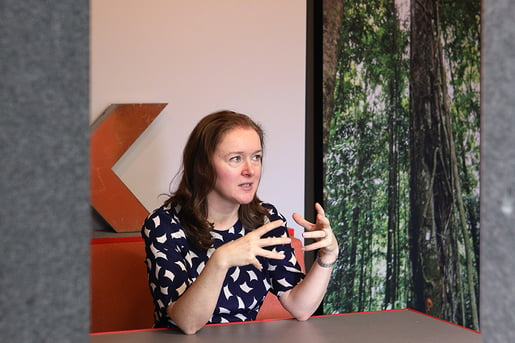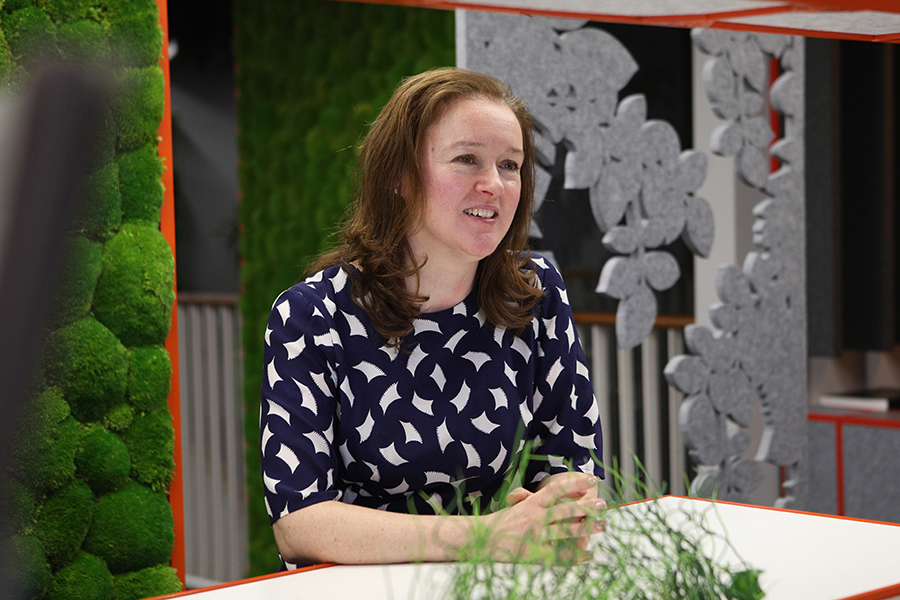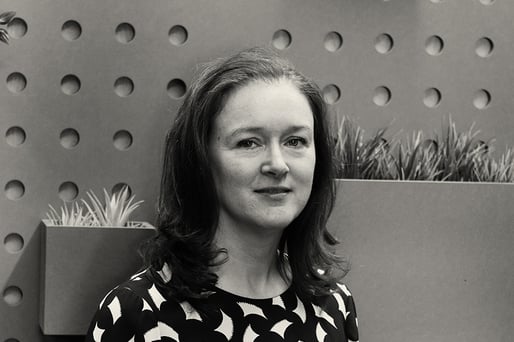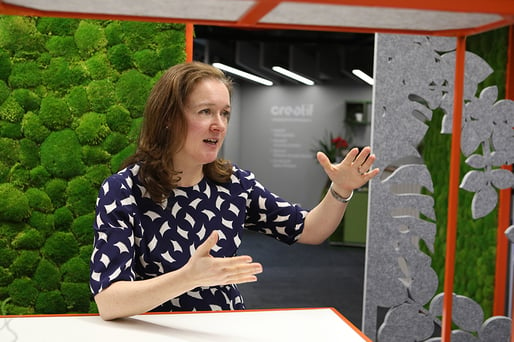|
Nicola Gillen is the Head of Total Workplace EMEA at real estate giants Cushman & Wakefield. As a workplace visionary and published author, Nicola has extensive experience within real estate and has lived and worked abroad for a number of years. It's this background and her impressive portfolio of work that guided our discussion onto topics such as the role architecture can play in affecting climate change, how important culture is when it comes to the workplace, the office of the future and what exactly the best environment for a neurodiverse workforce is.
Creatif: What made you want to pursue a career in architecture, as well exploring the many complex aspects of the work environment? Nicola Gillen: As a child I was always drawing. You’d find me surrounded by pens and pencils, as well as LEGO, so I was interested in design from a young age. At school I focused on art and science but it wasn’t until my teens that I actually discovered architecture. Students worry there’s a lot of maths in architecture, but it’s more about problem solving and communication than complicated mathematics. A turning point for me was in my first year at University, where I didn’t feel lecturers were preparing me to communicate with clients; the course was artistically focused, rather than people-focused, so I felt I needed to diversify. When I did my RIBA Part 2, Frank Duffy was president of the RIBA at the time and his focus was all about diversifying the role of the architect, which was great! As part of his residency he drove the creation of alternative Part 2s which had been heavily design-led courses. The university I went to offered five alternative Masters courses, including topics such as sustainability and computer aided design – which were obviously way ahead of their time – as well as a Business degree, which is the one I took. I was interested in how organisations work, and the role of environment and behaviour, and how one affects the other.
I worked as an architect in Dublin for a year, and during the recession I went to work in Singapore. This was an extraordinary experience as it provided me with loads of site experience. I really threw myself in the deep end, but truthfully, I knew I didn’t want to pursue a career as a traditional architect. Whilst I was in Singapore, Frank Duffy published one of his books called ‘The New Office’. It really resonated with me on a deeper level, so I wrote to DEGW from Singapore asking if there were any jobs. I got invited to come in for an interview in London and that’s where it all really began. Creatif: You’ve been involved with projects in numerous different countries. Does culture affect the way in which people behave in the workplace? NG: Hugely. As an Irish person, we have a culture of moving around the world and living in different countries. You turn 18 and travel the world. Ireland is very small, at the edge of a large continent, so we’re always looking out. It feels like it’s in my genes to travel, but I do believe that travel is as important as a formal education; living in the Far East really enabled me to experience a different way of life. There’s nothing quite like living in a different culture to give you an appreciation of your own values and somebody else’s. It makes you understand other people’s perspectives. As workplace is my focus, it’s very beneficial to have lived in a number of countries. I lived in New York for a while as well, which gave me a great insight into the American way of thinking, living and working. One of the reasons I love what I do is because the work environment is such a catalyst for behaviour. You can create PowerPoints explaining organisational restructuring but when you come along with moving crates, it gets real for people. We talk about working in a different way, which can be challenging for people [but] living and working overseas is a great lens into culture and behaviour. Creatif: Knowing that companies have such neurodiverse workforces, where do you begin when designing an environment for a new client? NG: The first thing to start with is an organisation’s business drivers. Are they seeking innovation, trying to save money, or get people to collaborate? Getting into the culture and people side is critical. You need to understand how people work. For the purpose of change management, if you don’t bring people with you - so they can understand why something is being done - it can be a much more difficult process.
Neurodiversity is of increasing interest to organisations. 10-15% of the population are neurodiverse in some way, and even those that are neurotypical are somewhere on the spectrum of introvert to extrovert. For decades we’ve been designing offices for extroverts, but now we’re beginning to see work environments that cater to a more diverse range of personalities. The environment can have a big impact on how people feel; the degree of openness, and how personal space feels to individuals. We’re looking at neurodiversity on a range of projects at the moment. For example, the UK government is very focused on inclusive spaces, arguably because they have such a diverse workforce. |
Creatif: In your book ‘Future Office’, you mention how we now have four generations working together for the first time. How would you create a workplace that is attractive to all four generations? NG: With all of us working for longer, and more young people entering the workforce, this will be of increasing importance. What I don’t like about the generational discussion is that it’s viewed as a conveyor belt. When anyone enters the workforce, it influences the dynamics of the team whatever age they are. There’s a huge focus on millennials, but the things that impact millennials affect everybody, such as technology and mobility. When I was at AECOM, we wrote about demographics using a circular diagram that organised generations into two big chunks: the age of responsibility, and the age of freedom. It proposed that the younger and older generations actually have more in common with each other as they have more time, they’re freer, have more disposable income, whereas the people in the middle with mortgages and children are more fixed. But when you blur the boundaries of age you can learn more from one another, especially within the workplace. Creatif: Real Estate is an incredibly competitive market. What do you think elevates Cushman & Wakefield from its competitors? NG: The design and construction industry is changing enormously. Through automation, it will be a very different industry in 10-20 years’ time. As architects, we need to be very focused on things like data science and psychology moving forward. Cushman & Wakefield operate both earlier and later in the supply chain compared to a traditional architecture firm. In terms of workplace there’s an opportunity to look at portfolio planning on a global strategic scale, and facilities management through building operation What’s more, Cushman & Wakefield is embracing the fact that automation is galloping towards us [and] we are actively evolving service offerings in response to these new ways of working. Creatif: To what extent do you think the architecture and design sector has contributed to the current focus on the impact of climate change? NG: Buildings are one of the biggest energy sources in Europe. I’d say there are two parts to that question: the energy and carbon required to build buildings, and the ongoing lifecycle costs of buildings when in use. One of the biggest opportunities design and construction has in the workplace is to connect with the way that people work as it’s much more distributed and remote than it ever has been. We’re actually working with an organisation that’s taking a ‘remote first’ stance by saying, “When you work with us, you won’t be primarily working on one of our real estate sites, you’ll be working from home first”. I believe this is the direction many organisations could head.
We’ll be building far less and we’ll be reusing what we’ve got. As architects we’ve got a huge responsibility to reuse what’s there, and if we are building anything from scratch, we’re building it with a circular economy in mind. Creatif: How difficult is it to get clients to see the value in non-working spaces, such as outdoor environments and leisure areas? NG: It’s a lot easier than it used to be. The staff voice has gotten stronger and stronger over the last few years. Organisations are increasingly aware of wellbeing. They’re realising that you don’t come to the office to be told what to do, you come to the office to do your best work. Gone are the days when you come to the office to do eight hours of silent solo work, so why would you provide rows and rows of desks? People come to the office to collaborate and network. Creatif: Regarding the workplace, if we could jump forward 50 years, what would you like to see as the norm, that today is considered radical? NG: Bill Gates said that we constantly overestimate the change that will happen in two years and underestimate what will happen in ten. I think that there’ll be very little in the workplace that we’ll recognise by 2050. In the short term, things like voice activation and automation will have a huge mark. There’ll be an increase in manual processing, speed and efficiency. I’m open to human augmentation and can see us working in a much more virtual way. We’ll come into the office far less, instead relying on avatars perhaps, which will mean global travel will plummet. It’s ludicrous that we’re flying all over the world, so from an environmental point of view, it would be extraordinary to have better virtual meetings.
|



